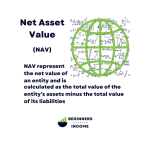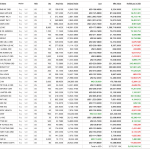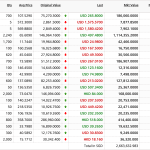[ad_1]

There are lots of choices now for investing in accounts meant for use for retirement. It may be somewhat overwhelming! Let’s break down the completely different choices you’ve gotten so to select which one makes probably the most sense for you.
Retirement Accounts
The thought is that you would be able to put your cash into an account, select which investments to purchase, after which not have to fret about paying taxes yr by yr while you’re contributing to the account. That is in opposition to a taxable account or non-retirement account in which you’ll owe taxes within the tax yr you promote an asset for a achieve or accumulate revenue.

The problem is available in when you’re introduced many choices and flavors of those accounts with their various guidelines.
Conventional Particular person Retirement Account (IRA)
This account is taken into account a pre-tax account. The logic right here is to place cash out of your paycheck right here (2024 max annual contribution of $7,000 or $8,000 if you happen to’re 50 years outdated and older), let your investments develop with out being taxed, after which if you retire you’ll be taxed at strange revenue if you withdraw from this account.
One attention-grabbing rule that works with all retirement accounts is that you would be able to withdraw funds for 60 days tax-free, offered they’re put into one other retirement account by the tip of the 60 days. That is referred to as an oblique rollover and is allowed as soon as per yr per retirement account. Some IRA suppliers don’t have the power to immediately switch funds to a different supplier so they’ll ship you a private examine and you might be accountable to place it in one other IRA inside the timeframe.
For these of us who’re bold, that is mainly a 2 month 0% curiosity mortgage you possibly can take from your self, so long as it’s paid again in full by day 60. The alternatives, and dangers/foregone good points, are infinite with what you would do with the cash inside these 60 days!
Professionals
- Delay paying taxes. Perhaps you assume you’ll be in a decrease tax bracket in retirement than in your working years
- In case you go away a job, you possibly can rollover (rollover or switch) your pre-tax employer plan into this account
- You get a tax deduction for contributing pre-tax {dollars} to this account
- Sometimes extra funding choices than an employer plan (shares, bonds, CDs, mutual funds, ETFs)
- You’ll be able to contribute 100% of your revenue or the max contribution, whichever is much less
Cons
- Withdrawals are thought of revenue and can add to your taxable revenue, which may push you into one other tax bracket when you’ve got different revenue streams, thus growing your tax legal responsibility
- As of 2024, when you attain 73 years outdated, you will need to start taking required minimal distributions (RMDs) which has the identical have an effect on because the earlier level
- Low max contribution restrict in comparison with most employer plans
Employer Plans

Every employer might have it’s personal algorithm so we’ll simply go over the final guidelines and parts right here. So as to retain workers, employers provide accounts (401k, 403b, SIMPLE/SEP IRA, Pension, and so on.) that both the employer invests in and/or the worker invests in for his or her future retirement.
You’ll be able to select between pre-tax contributions or after-tax contributions, however regardless the good points are thought of pre-tax. As soon as you permit a job, some plans will let you roll earlier plans into your new jobs plan or you possibly can roll it into a standard IRA (typically known as a rollover ira however nothing basically completely different).
Professionals
- Larger contribution limits than a Conventional or Roth IRA
- You’ll be able to spend money on each an employer plan and a Conventional IRA or Roth IRA (not all 3)
- Generally the employer will make a contribution and/or match worker contributions
- In case you want cash out of your plan, to keep away from taxes, you possibly can leverage your employer plan by taking out a mortgage towards the worth of the plan (generally is a con if you happen to can’t pay it again)
- In case you personal your personal enterprise, you possibly can arrange your personal employer plan and contribute as each the employer and worker. This can lead to saving +$50,000 yearly relying in your revenue and the way you’ve structured your plan.
Cons
- Restricted funding choices
- Vesting schedules, or time till you’ve gotten full entry to the cash in your account, can differ relying on the employer
- Numerous plan particular guidelines and costs
- In case you withdraw funds too early (earlier than you might be 59 1/2 years outdated), you’ll not solely get taxed on the distribution however may face a penalty as nicely, shedding extra of your funds
Roth IRA
This account is much like the normal ira, however this ira is contributed to with solely after-tax {dollars}. As soon as contributed, the contributions may be withdrawn tax-free. After assembly sure timing and age guidelines, the good points will also be withdrawn tax-free.
There are revenue limits, so throughout the yr if you happen to’ve been contributing to a Roth IRA and your revenue reaches above the restrict, you’ll need to both take out the contributions to your financial institution or open a Conventional IRA and switch (generally known as recharacterize) the Roth IRA contribution to the Conventional IRA.
Professionals
- Accounts may be opened for Minors with an grownup because the custodian (earned revenue nonetheless required with the intention to contribute)
- Contributions may be withdrawn tax-free at any time
- Certified withdrawals (medical emergency, first time dwelling buy, and so on.) will also be tax-free, work with a tax accountant to make sure it qualifies.
- Even when your revenue is simply too excessive to immediately contribute to a Roth, you possibly can contribute to a Conventional IRA and convert (switch) the contribution to a Roth IRA. That is generally referred to as a “back-door” Roth contribution/conversion
- Comparable funding choices because the Conventional IRA (shares, bonds, CDs, mutual funds, ETFs)
Cons
- As of 2022, solely $6,000 ($7,000 if 50 years outdated or older) most contribution per yr, not per account when you’ve got a number of accounts
- Revenue limits make it troublesome for top earners to contribute
- As with the remainder of the retirement accounts, there are withdraw guidelines you will need to observe so make certain you’ve gotten some liquidity elsewhere to keep away from drawing on this account steadily
Self-Directed IRA (SDIRA)
This sort of account just isn’t steadily talked about in finance programs or on the large brokerage homes the place many individuals have retirement accounts. SDIRAs merely will let you spend money on no matter you need. So long as it’s not your private home or private belongings, you should buy it. This choices offers you the power to reap all the advantages of a retirement account, whereas having the choice to spend money on investments that curiosity you.
There are particular corporations that you’ll have to search out who provide some of these accounts. SDIRAs are usually extra expensive than the accounts we’ve already talked about with month-to-month or annual charges primarily based on the sort or variety of investments you maintain. Nonetheless, this generally is a small value to pay if the funding alternative is bigger.

Professionals
- Put money into non-traditional belongings (cryptocurrency, artwork, commodities, actual property, personal investments, loans, and so on.) that don’t observe main inventory/bond market cycles
- You’ll be able to rollover or switch funds from earlier retirement accounts into this one
- When you have specialised information in a selected area, you need to use these funds to spend money on these much less identified alternatives
- You’ll be able to select between making it a pre-tax or after-tax account
Cons
- Contribution limits observe beforehand talked about choices relying on how it’s structured (conventional, Roth, employer plan, and so on.)
- Paperwork and costs required to open the account, in addition to for every funding and transaction
- Larger danger with belongings that aren’t publicly traded
- Illiquidity danger with belongings it’s possible you’ll not management or be capable to get your cash out of if you happen to want funds in an emergency
- Possession in companies, actual property, personal investments, and so on. can open you as much as the opportunity of lawsuits that will have an effect on the belongings you acquire
How does this assist me develop my passive revenue?

Asset location is simply as necessary as asset allocation. After you make your funding choice, you will need to then determine which account is one of the best place to carry your funding to maximise your return.
In case you are simply beginning out, it’s possible you’ll determine you possibly can solely afford to purchase just a few dividend shares. Thus you would look to open a Roth IRA and begin increase your tax-free passive revenue streams. This additionally offers you the choice to recall the contributions must you get in a pinch with no tax or penalty ramifications.
What if you happen to’re a excessive earner and have been placing cash away in a 401k for years and also you determine you need to diversify into personal investments or actual property?
You could determine to switch a few of your 401k cash to a SDIRA and start diversifying your investments. You may additionally contemplate changing your 401k pre-tax contributions to after-tax if you happen to imagine your revenue will proceed to develop and need to pay at your present tax price.
Perhaps you’ve gotten an on-line enterprise and have lastly constructed up sufficient revenue streams to step away out of your day job to work in your channel/web site/enterprise full-time. When you have cash leftover from investing in your small business and paying your self, it’s possible you’ll contemplate opening your personal employer plan so it can save you greater than you ever may earlier than. Employer contributions are an expense that might scale back your companies taxable revenue.
All these accounts have the potential to profit you in your passive revenue journey. By understanding how your investments can be taxed, you possibly can know the place the max profit lies for you relying in your private circumstances. Tax and authorized advisors may also assist you in figuring out the best account construction for a given funding however they will’t let you know if the funding is a good suggestion, that’s your job!
[ad_2]
portfolio-management-retirement-accounts-beginners-passive-income






